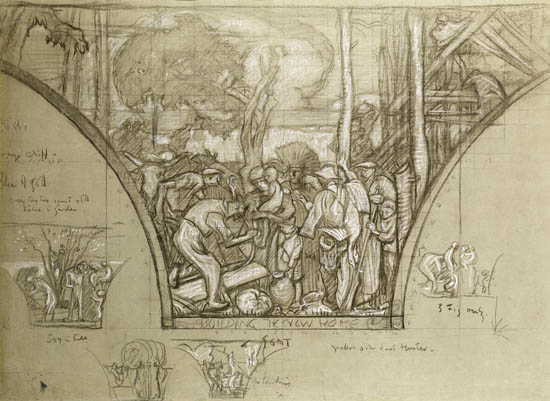
Home-Makers, circa 1920
Framed (ref: 5313)
Inscribed Building the New Home with additional various notes
Black and white chalk, 23 1/4 x 28 1/4 in. (59 x 72 cm.)
Tags: Frank Brangwyn chalk work

Inscribed Building the New Home with additional various notes
Black and white chalk, 23 1/4 x 28 1/4 in. (59 x 72 cm.)
Tags: Frank Brangwyn chalk work
Provenance: Abbot & Holder 2002, private collection. Literature: Roger Alford & Libby Horner (Eds), Brangwyn in His Studio, The Diary of His Assistant Frank Alford, 2004, p70
Literature: D. Wilson, ‘The Mysterious Case of Frank Brangwyn – Brangwyn In His studio - The Diary of His Assistant Frank Alford (2004)’ The British Art Journal, Vol. VI, No. 1 (June 2005), pp. 86-7.
This is a study for
one of four pendentives painted for the State Capitol, Jefferson City,
USA, 1915-1925, the murals representing 'Missouri in Four Great
Historical Periods'. the other titles were Historic Landing, Pioneers
and Builders.
This original drawing is on of a 100 works by
Brangwyn better known through its appearance in the Brangwyn Portfolio
where it appears as a reproduction measuring 27.5 x 38 cm. The
Brangwyn Portfolio published, by E F d'Alignan and Paul Turpin in 1927,
was a response to the demand for high quality reproductions of
Brangwyn's work. Brangwyn himself chose 100 items which he felt were
representative of his range of disciplines, including 12 original
etchings and 3 original lithographs. The remaining 85 works were
lithographic reproductions of watercolours, pastels and drawings
produced by photomechanical means to which Brangwyn and his assistants
added chalk or watercolour through stencils, giving the impression of
original works. In fact such is the quality of these reproductions that
they are frequently mistaken for the real thing - even by the top
auction houses.
The folios, presented in a folder measuring
45x64cm, were produced in a limited edition of 120, costing 100 guineas
each. Most were sold to Japan, America and Europe. Works produced before
1922 were numbered 1-50, before 1927 were numbered 51-100.